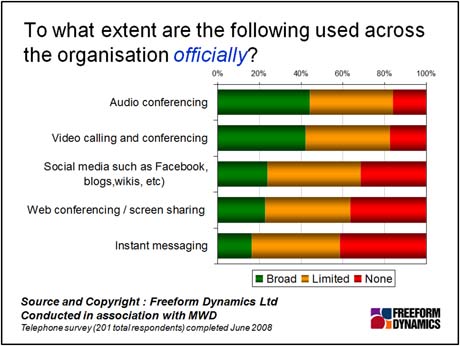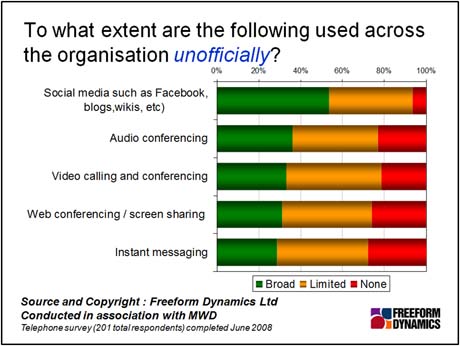Socialtext, known for its enterprise wiki solution, made a serious play for the enterprise 2.0 space, by launching Socialtext 3.0 on Tuesday. The application trio includes the new Socialtext People, for social networking, a la Facebook for the Enterprise, Socialtext Dashboard, a la NetVibes, a collaborative workspace, and an overhaul to Socialtext Workspace, the existing enterprise wiki application. Socialtext also announced Socialtext Signals, an enterprise microblogging system (think Twitter for the enterprise), which will be released in a few months. The flexibility and modularity of the applications allow an enterprise to set up the systems for individual, team, company-wide and extranet use. Customization options exist with dashboard plugins. The new applications will be available as a hosted platform and as an on-premise appliance.
The demos are impressive. Sleek, with little distraction, the applications are simple enough for a social networking newbie to use, but engaging enough for the social networking guru. Of course, once my colleague, David Tebbutt, and I tried the application, we realized that a lot of the nice look and feel of the demo comes from the user added content and customization. For people who don’t have the initiative or the skill to build out the tools, out of the box utility might be challenging, and without the effort to build it out, user’s stickiness will be jeopardized, as is the case with all enterprise platforms. But, the price is right, at $10 per user per month, Socialtext comes in below some competitors, but similar to SharePoint pricing. The cost encourages relatively risk free experimentation with social media.


According to Socialtext founder Ross Mayfield, essentially two forces drive enterprises to utilize enterprise 2.0 tools. One is grassroots support for the tools that spread up from movements at the business unit level, often sales, marketing and business development, the other force is otherwise stodgy corporations that ban consumer social media but feel they must offer their disconnected employees some appeasement. In June 2008, we conducted research that corroborates that unofficial, grassroots support leads to substantial unofficial adoption of social media tools (see charts following this paragraph) According to Brett Guretize, Epitaph Records founder and Socialtext user, not only does Socialtext improve collaboration, it makes working together “more fluid, and more fun.” Together, these concepts show that enterprise 2.0 is in an evolution, in the midst of an identity crisis, rising from the bottom but occasionally coming from the top, and both a useful tool, and a fun tool, the latter function possibly making some corporate managers cringe.


If making enterprise 2.0 a reality was simple as facilitating one to one, one to many, and many to many conversations for sharing knowledge about individuals, activities and the corporations, with an easy to use and scale format, then Socialtext 3.0 adds up. But does a good set of tools enable collaboration and communication, or must these factors need to exist for the tools to be implemented and successful? As we’ve noted, without content, the tools themselves are just tools, but could inspire content generation in the right hands. Unfortunately, this chicken and egg situation is one of the critical unanswered questions in enterprise 2.0.
One concept Socialtext has nailed is the uniqueness of enterprise social networking, compared to consumer social networking. In the enterprises, users, and their IT overseers and business managers, want the signal to noise ratio rather high. By design, Socialtext adds context around conversations and users, and avoids pointless broadcasts. For example, users can get announcements focused on team members they work with and projects they support.
Another area Socialtext is working on is being able to integrate with other, bigger brand collaboration tools. Productized “connectors” are available with Microsoft SharePoint and IBM Lotus Connections. Of course, both Microsoft and IBM are also competitors in the field, leaving me to wonder just how close and strategic the relationships with such companies will be over time. Other strategic partnership opportunities include mash ups with systems like Salesforce.com, providing, for example a seamless connection between the systems that pops up an announcement in Socialtext if a sales member closes a key account. In tying closely to other enterprise applications, Socialtext can increase its value and decrease the “just another system to manage” challenge it can face.
With strong competition from Microsoft’s Sharepoint on the established front, and competition from many small companies that provide pure play collaboration functionality, such as Twitter-for-the-enterprise, (YuuGuu, Yammer, and so on), Socialtext must execute well, and find the right channel. While small companies might be the darlings of grassroots efforts, large companies have the respect of the establishment. One issue I have with Socialtext 3.0 today is that Signals did not come integrated with it. In his blog pitch, Mayfield states that Signals is the essential glue to hold People, Dashboard and Workspace together, and it’s not there. This opens up a window to let the competition catch up.
Through our research and insights, we help bridge the gap between technology buyers and sellers.





Have You Read This?
From Barcode Scanning to Smart Data Capture
Beyond the Barcode: Smart Data Capture
The Evolving Role of Converged Infrastructure in Modern IT
Evaluating the Potential of Hyper-Converged Storage
Kubernetes as an enterprise multi-cloud enabler
A CX perspective on the Contact Centre
Automation of SAP Master Data Management
Tackling the software skills crunch